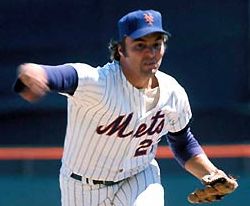The GM is one of the most despised people in New York. People are calling for the manager to be fired. The entire team is neither executing nor playing fundamentally sound baseball. We’re not hitting and fans are now outnumbered by empty seats. The Mets seem destined for a 90+ loss season and avoiding 100 losses will be an accomplishment. The Yankees own the city. Opposing teams are chomping at the bit when they arrive in Flushing. There seems to be little hope and only darkness on the horizon for years to come.
But in the midst of this we have one bright spot… A young and very talented pitcher that we are pinning our hopes on. He will become the ace of our staff. He will become our new Tom Seaver.
My question is this: Am I referring to the 2013 Mets or the Mets of the late seventies? Am I talking about Matt Harvey or Craig Swan?
The more things change, the more they stay the same.
 Craig Steven Swan was born in California (just like Seaver) on November 30, 1950. He was the Mets third round pick in the 1972 draft. After Swannie pitched in the ’72 College World Series and allowed just one earned run in 18.0 innings pitched, fans saw a dynasty coming. A guy like this would be joining Seaver, Koosman and Matlack. Wow!
Craig Steven Swan was born in California (just like Seaver) on November 30, 1950. He was the Mets third round pick in the 1972 draft. After Swannie pitched in the ’72 College World Series and allowed just one earned run in 18.0 innings pitched, fans saw a dynasty coming. A guy like this would be joining Seaver, Koosman and Matlack. Wow!
From 73 through 75, Swan battled inconsistency. He was regularly shuffled back and forth between New York and Tidewater – the Mets AAA affiliate at the time. By 1976, however, Swan became our number five starter behind our Big Three and Mickey Lolich. He was finally here to stay.
However, his inconsistency rattled the nerves of fans. His first four starts were downright awful. Then, over his next three, he allowed just one earned run and 13 hits in 26 innings. The Mets won 86 games that season and Swan went 6-9 with a respectable 3.54 ERA.
In 1977, M. Donald Grant traded away “The Franchise” and ripped out the hearts of Mets fans. Losses went up, attendance went down. The Mets finished in last place, 37 games back. Our 98 losses were the most in a decade. Swan finished with a 9-10 record and posted a disappointing 4.23 ERA. However, his nine victories were more than both Koosman and Matlack that season.
By 1978, the Mets had sunk to new lows and were downright terrible. And although we still had Kooz, it was becoming clear that #36 was disgruntled and wanted to get the hell out of New York. Craig Swan assumed the role of de-facto ace. He was a good pitcher on a bad team. (Matt Harvey anyone?)
Swan’s first start of the year was a complete game shutout, allowing just five hits. On July 4th, 1978, the Mets’ brightest star fanned 13 but took a 3-2 loss. He dropped to 1-5, yet his ERA was a Seaver-esque 2.66. On September 16th, in spite of allowing just three hits and one earned run over none innings, the Mets’ bats were quiet as usual. Swan failed to secure the “W.”

When the curtain came down on the 78 season, Craig Swan led the National League with a 2.43 ERA had the league’s second best WHIP. At Shea his ERA was 1.67. His record, however, was 9-6. Good pitcher. Bad team. On a good team, with stats like these, Swan would have probably been a 20 game winner.
By 79, Koosman was now gone and Swan found himself the Mets ace. He made 35 starts, tossed 251 innings, racked up ten complete games – three of them shutouts. His 3.29 ERA was led the team and remarkably his 11 wins were more than any two other Mets combined.
Perhaps he really was our new Seaver as the young righthander was now our lone beacon of hope. Management forked over $3.25 million for five years and made Craig the highest paid pitcher in team history.
He was well worth it and 1980 saw Swan yet again pitch masterfully. Although the Mets were still awful and providing him with no run support, Swan was 5-4 with a superb 2.21 ERA through mid-June.
And then, just like that, he fell apart.
His velocity dropped and suddenly his command became uncharacteristically erratic. He couldn’t get anyone out. One month later it was determined that the Mets ace had torn his rotator cuff. Back then, surgery was not yet an option as it is today, and it appeared that Swan’s career was most likely at an end. But Swan did what most pitchers at that time did; he rested. After a month off he returned to make two more terrible starts before we landed back on the DL and was lost for the season.
In spite of the torn rotator, Swan was back on the mound the following April. In his second start of the season, he walked leadoff man Tim Raines on four pitches. On his fifth pitch, also a ball, Raines broke for second base and Mets catcher Ron Hodges attempted to nail the speedy Raines. However, Swan had his back to the plate and Hodges’ throw slammed right into Swan’s back resulting in a fractured rib. A Metsian moment to be sure.
Swan returned to the DL yet again. He was now dealing with the fractured rib as well as coming back from the torn rotator cuff. He made two ineffective relief appearances later that spring… And then the baseball strike of 1981 happened. Swan came back after the strike, continued struggling and spent the remainder of the season on the DL. The Mets ace, the highest paid pitcher on our staff, tossed 13.2 innings that season.

By 1982, we were beginning to see some light at the end of the tunnel. The long dark days appeared to be coming to an end as a couple of kids named Mookie Wilson and Hubie Brooks brought some excitement back to Shea. We were also hearing great things about a couple prospects in the minors named Dwight Gooden and Darryl Strawberry. Lo and behold the Mets, now under new ownership and a new GM, acquired RBI machine and a legitimate home run threat – former MVP George Foster.
And in the middle of all this, Craig Swan bounced back big time. Although the Mets still struggled, going 65-97, Swan again found himself the ace on a bad team. He was the Mets leader in ERA (3.35) and wins (11). and was the only starter to post a winning record. For his efforts he finished second to Joe Morgan for NL Comeback Player of the Year. Swan was also used out of the bullpen that season and compiled a solid 1.30 ERA working out of the pen.
It was during Spring Training in 1983 when the 32-year old Swan felt “something pop.” His myo-fascial tissue had been ripped from his triceps. He again attempted to pitch through this new injury. The battler and bulldog that he was, realized he was.the ace and that his team needed him. However, it was to no avail as he went 2-8 with a 5.51 ERA, and ultimately he was shut down again.
It was a devastating blow, but fans were distracted because the Mets acquired a new pitcher – Tom Seaver was back in a Mets uniform and Swan’s career-ending injury was just a mere footnote. Swan was overshadowed by the very man he was supposed to become.
By 1984, the Mets seemed poised to compete. There was something different in the air. Hope? Promise? Craig Swan who spent years being a very good pitcher mired on a very bad team would finally get to be on a competitor. However, it was not meant to be.
It was obvious the injuries had finally taken taken a toll and gotten the better of him. In 18.2 IP he allowed 17 ER and five home runs. The Mets ace, the man who was destined to replace Seaver, the man who landed that record $3.25 million contract, was sadly released on May 7, 1984.
He was picked up by the Angels but after getting knocked around twice, they released him as well. The promising kid from California who was going to lead the Mets to glory, was now out of Major League Baseball at the age of 33.
After spending his career dealing with and learning about injuries, Craig Swan became a huge believer and follower of Rolfing. It’s described as a holistic system of soft tissue manipulation that organizes the whole body in gravity. He currently lives in Stamford, CT where he operates a physical therapy facility that specializes in Rolfing.
On September 28, 2008, the Mets brought down the curtain on Shea Stadium after 45 seasons. A handful of former Mets were invited to be on hand and 57 year old Craig Swan was one of them. As he scanned the stadium and glanced at the same pitching mound where he once was the ace of the Mets, who did he see? Tom Seaver, on the rubber, throwing the ceremonial “Final Pitch” to another beloved Met, Mike Piazza. Craig Swan was once again in Seaver’s shadow.
Days later, Swan was at work at his Rolfing practice in Connecticut when he looked up to see none other than his good friend and former teammate walk in. It was Tom Seaver. The Hall of Famer had spent fourteen days in traction in nearby Greenwich and was still in pain. His back was messed up and he seeked out Swan of all people for help. Craig explained to Tom the theory behind Rolfing and how it works. It was now Swan doing the teaching. He educated his former teammate on how to “soften” his toes while walking and how this would help to alleviate his back pain.
Seaver jokingly asked, “Swannie, how am I supposed to see what my toes are doing? They’re inside my shoes.”
Craig Swan smiled, affectionately put his arm around his friend and replied, “You’ve got three Cy Young Awards. I’m sure you can figure it out.”















